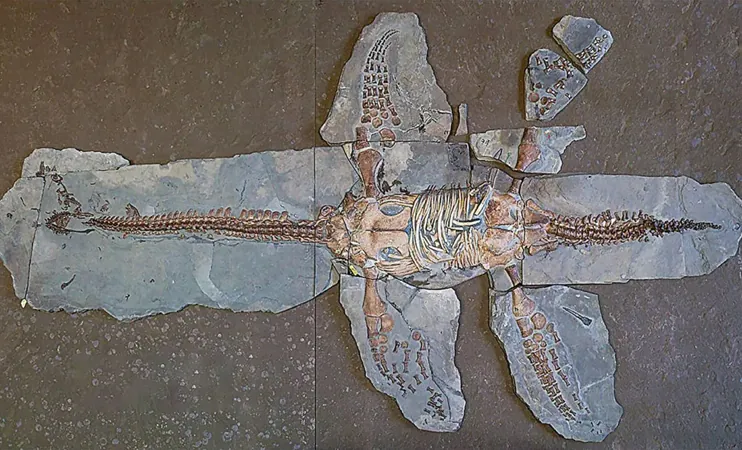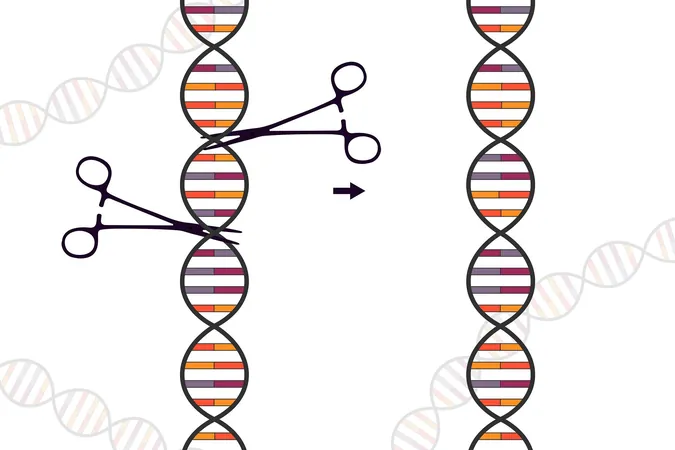
Ancient Marine Reptile Fossil Provides Surprising Insights Into Evolution and Lifestyle
2025-06-01
Author: Noah
A remarkable find from the ancient seabeds of modern Germany is turning the paleontological world on its head. A 183-million-year-old fossil of *Plesiopterys wildi*, unearthed in Holzmaden, is delivering unprecedented insights into the anatomy and evolution of marine reptiles, especially regarding how they moved and interacted in their environment.
A Time-Capsulated Fossil: Secrets Unveiled After Decades
Discovered back in 1940, this exceptional specimen, known as MH 7, remained hidden beneath limestone until recently. After careful preparation in 2020, technicians revealed astonishingly preserved patches of skin and scales, offering a rare look at the soft tissues of Jurassic reptiles. Microscopic studies identified two types of keratin—beta-keratin on the scaled flippers and alpha-keratin on the tail—indicating distinct functions, such as enhanced aquatic propulsion.
"The Holzmaden specimen grants us a unique perspective on *Plesiopterys wildi* at a mature growth stage, refining our understanding of this creature's evolutionary role,” emphasized Miguel Marx, the study's lead author from Lund University.
Skin Deep: Color and Functionality
Analysis of the tail's skin suggested a complex surface filled with melanosomes—pigment cells that indicate a potentially mottled coloration. This challenges prior beliefs that marine reptiles were exclusively pale or monochrome, suggesting that *Plesiopterys* may have had evolutionary adaptations for camouflage or communication, similar to today's aquatic species.
Structurally, the flippers showed features designed for maneuverability, with a keratinous lining and scaling supporting efficient thrust and agility—traits reminiscent of the forelimbs of contemporary sea turtles. This specialization indicates that *Plesiopterys* not only escaped predation but actively engaged in sophisticated aquatic navigation.
Steering and Speed: The Unexpected Tail Advantage
Perhaps the most thrilling revelation is the discovery of a fleshy tail fin—a rarity among plesiosaurs. This broad, flexible adaptation would have functioned like a rudder, significantly enhancing the reptile's ability to turn sharply and accelerate swiftly. When coupled with its long neck and four powerful flippers, *Plesiopterys* might have had an unparalleled capacity for agility in the water.
These findings suggest a shift in our understanding of ecological interactions in prehistoric marine environments, revealing that *Plesiopterys wildi* didn't just rely on speed to evade predators like ichthyosaurs and ancient crocodilians but cleverly maneuvered to outwit them—a strategy that sheds light on the complexities of its survival.
A Glimpse Into Prehistoric Life
This remarkable fossil not only changes our perspective on plesiosaurs but hints at diverse evolutionary paths taken by isolated marine species in early Jurassic waters. These intricate evolutionary adaptations are far more than mere curiosities; they provide a deeper understanding of how life thrived in ancient oceans and could reshape theories on marine reptile behavior and ecology.









 Brasil (PT)
Brasil (PT)
 Canada (EN)
Canada (EN)
 Chile (ES)
Chile (ES)
 Česko (CS)
Česko (CS)
 대한민국 (KO)
대한민국 (KO)
 España (ES)
España (ES)
 France (FR)
France (FR)
 Hong Kong (EN)
Hong Kong (EN)
 Italia (IT)
Italia (IT)
 日本 (JA)
日本 (JA)
 Magyarország (HU)
Magyarország (HU)
 Norge (NO)
Norge (NO)
 Polska (PL)
Polska (PL)
 Schweiz (DE)
Schweiz (DE)
 Singapore (EN)
Singapore (EN)
 Sverige (SV)
Sverige (SV)
 Suomi (FI)
Suomi (FI)
 Türkiye (TR)
Türkiye (TR)
 الإمارات العربية المتحدة (AR)
الإمارات العربية المتحدة (AR)